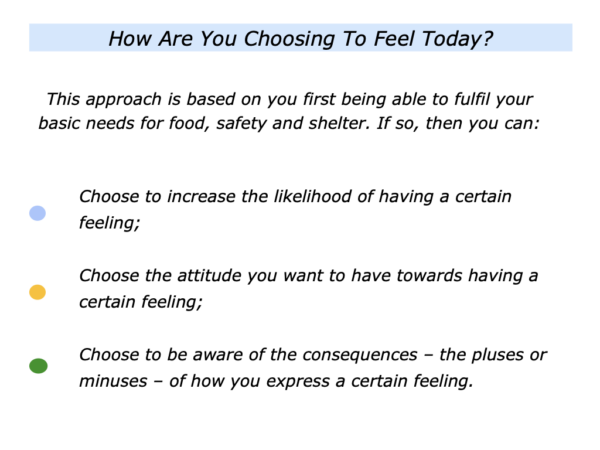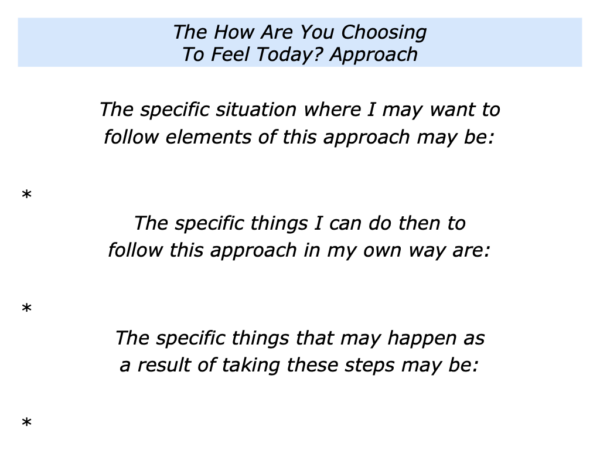
There are many ways to live life. This approach explores how a person can choose to increase the likelihood experiencing certain feelings in life.
The first step, of course, is for a person to be able to satisfy their basic physical needs. They need food, safety and the basic materials for life. They can then focus on their psychological needs.
Every person is different. They will have had different experiences and models in their lives. These will influence how they manage their emotions. There comes a point in their life, however, when a person can choose their attitude in certain situations.
Many people recognise the specific things they can do to increase the likelihood of them feeling positive or negative. They may also recognise that the way they behave has consequences – both for themselves and other people.
Viktor Frankl highlighted this approach in his book Man’s Search For Meaning. This described his journey as a prisoner in the Nazi concentration camps.
The daily horrors left much to chance and survival could depend on the whim of a guard. Trying to make sense of the madness, Viktor described what he saw as the last human freedom. He described this in the following way.
Everything can be taken from a man or a woman but one thing: the last of human freedoms to choose one’s attitude in any given set of circumstances, to choose one’s own way.
This is an approach I built on when working with people. Greeting them in a positive way, I would also ask:
“How are you choosing to feel today?”
When appropriate, we then began to focus on the theme of choices and consequences. Bearing in mind the things they could control, we focused on the choices they wanted to pursue in their lives or work.
They could choose their attitude, aspirations and how they wanted to work towards potential achievements. They could also choose to increase the likelihood of having certain feelings. The choices they made could have consequence – both for themselves and other people.
Imagine that you want to follow elements of this approach. You may want to increase the chances of having certain feelings. Or you may have a professional role where you are helping others to shape their future lives. Let’s explore the following themes.
Choosing to increase the likelihood
of having a certain feeling
How can you help to shape your feelings? One approach is to ask yourself the following questions.
What are the specific things I can do to increase the chances of feeling positive? What can I do to increase the chances of being happy? What can I do to increase the chances of developing my strength to deal with challenges?
What have I done in the past to develop these feelings? What did I do right then? What were the principles I followed? How can I follow these principles – plus maybe add other skills – to have these feelings in the future?
What can I do to encourage myself? What can I do to count my blessings? What can I do to build on my personal and professional assets? What can I do make the most of my life on Earth?
What can I do to put myself into positive circles? What can I do to put myself into negative circles? What will be the consequences of taking each of these approaches?
What are the feelings I want to have in the future? How can I do my best to increase the chances of having these feelings? What will be the consequences – both for myself and other people?
There are many ways that a person can be helped to shape their feelings. Let’s look at another approach.
Choosing the attitude you want to
have towards having a certain feeling
A person can sometimes feel out of control, worried or have another challenging feeling. They may say something like:
“I feel really down and am not sure how to deal with this feeling.”
How to help them to retake control? Some people may respond by showing empathy, some may make suggestions. When appropriate, there is another approach.
This involves inviting the person to take charge of shaping their future. It is to ask the person:
“What is the attitude you want to take towards having this feeling?”
This involves helping the person to find ways to manage the feeling rather than let the feeling manage them. One approach is to help the person to recognise the circle of feeling, talking and doing.
Imagine, for example, that for some reason you feel bad. It can then be useful:
To acknowledge that you have a certain feeling – such as sadness, disappointment or another difficult feeling;
To decide that you want to have a better feeling;
To do something that is likely to increase the chances of having that feeling.
Some people love to talk about how bad they feel. This can help for a while but it can lead to them falling into a negative cycle.
Reflecting is vital but then comes the crunch. Some people substitute talking for action. They may find that their analysis leads to a downwards spiral. They may say, for example:
“Why can’t I do something? Before I move forward, I must understand the barriers stopping me.”
If they feel overcome by problems, however, there is a quick way to change that feeling. They can do something that will encourage themselves or other people.
Feeling, talking and doing are all important. If somebody wants to feel differently quickly, however, they can do this by behaving differently. People can choose what they do and, in this way, help to shape their future feelings.
Choosing to be aware of the consequences
of how you express a certain feeling
A person may sometimes want to talk about their feelings or express these in other ways. Many people find this a good way to manage or deal with feelings.
Some people may do this in helpful way. They may find it helps to heal themselves. It can also sometimes lead to deepening relationships with other people.
Some people may express their feelings in not so helpful ways. Sometimes this can have less helpful consequences – both for themselves and other people.
When appropriate, a person may therefore find it helpful to buy time to reflect. They may then want to explore the following questions.
What am I feeling at the moment? What do I want to do about this feeling? How can I manage it in, as far as possible, a positive way?
Do I want to express this feeling in any way? If so, what are the possible ways I can express this feeling? What may be the consequences – the pluses and minuses – of each option? What may be the effect – for myself and for other people?
Bearing these things in mind, what is the route I want to take to express the feeling? How can I express it in a way that helps – rather than hurts – myself or other people? What are the steps I can take to make this happen?
Such an approach sounds difficult – especially during heated moments or times of distress. But it is route is worth considering.
Some people find it useful to explore the possible choices they have and the consequences of each option. They may then choose to express their feeling in a way that is helpful rather than hurtful for themselves and other people.
There are many ways to live life. This section has explored how a person can choose to increase the likelihood experiencing and managing certain feelings.
Let’s return to your own life and work. Looking ahead, can you think of a specific situation where you may want to follow elements of this approach? How can you do this in your own way?
If you wish, try tackling the exercise on this theme. This invites you to complete the following sentence.



Leave a Reply